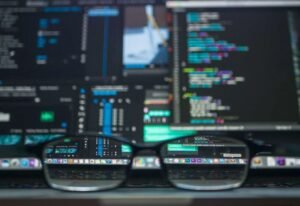Introduction:
In today’s digital age, technology is transforming the education sector, allowing for innovative and interactive learning experiences. Educators and students alike can benefit from incorporating technology into the classroom. This blog post will explore the various ways in which technology is being used for learning purposes and discuss the positive impact it can have on student engagement and academic achievement.
Key Takeaways:
– Technology in education promotes interactive and hands-on learning experiences.
– Online resources and tools enhance the accessibility and flexibility of education.
– Gamification and virtual reality can improve student engagement and motivation.
– Technology can personalize learning and cater to individual student needs.
– Digital literacy and technology skills are essential for future workforce readiness.
Enhancing Learning with Technology:
Technology has revolutionized the way education is delivered, moving away from traditional chalk and talk methods to more interactive and engaging approaches. Through the use of various digital tools and resources, students can actively participate in their own learning, fostering a deeper understanding of the subject matter. *By leveraging technology, educators can create more immersive learning environments that spark curiosity and promote critical thinking.*
1. Gamification in Education:
Incorporating elements of gamification into the classroom can significantly enhance student engagement. Digital platforms and educational games can turn learning into a fun and interactive experience. *Gamification fosters a sense of competition and rewards, motivating students to actively participate and excel in their studies.* Some popular gamification tools used in education include Kahoot, Quizlet, and Prodigy.
2. Virtual Reality:
Virtual reality (VR) is another technology making its way into classrooms, offering immersive learning experiences. It allows students to explore and interact with virtual environments, bringing concepts to life. *With VR, students can travel through time and space, visit historical sites, or even explore the human body, making learning a truly multisensory experience.* Companies like Google Expeditions and Oculus offer VR solutions specifically designed for educational purposes.
3. Personalized Learning:
Technology enables personalized learning, allowing educators to tailor instruction to meet each student’s individual needs. Adaptive learning platforms leverage data analytics and machine learning algorithms to provide students with personalized learning paths. *By analyzing a student’s strengths and weaknesses, these platforms can deliver content and resources targeted to their specific learning needs.* Some popular adaptive learning tools include Khan Academy, DreamBox, and Aleks.
Tables:
Table 1: Benefits of Technology in Education
| Benefit | Description |
|———————————————|———————————————————————————————-|
| Enhanced student engagement | Technology makes learning more interactive and fun, increasing student motivation. |
| Improved educational access and flexibility | Online resources and tools allow for anytime, anywhere learning, catering to diverse needs. |
| Personalized instruction | Technology can adapt content to meet individual student needs, improving learning outcomes. |
| Promotes collaboration and communication | Digital tools facilitate communication and collaboration among students and educators. |
| Develops critical thinking and problem-solving skills | Technology encourages creative problem-solving and enhances critical thinking abilities. |
Table 2: Top Educational Gamification Tools
| Tool | Description |
|———-|———————————————————–|
| Kahoot | Interactive, competitive quizzes for classroom engagement. |
| Quizlet | Flashcards, games, and study tools for various subjects. |
| Prodigy | Math gaming platform that integrates curriculum content. |
| Minecraft | Virtual world-building game that can be educational. |
Table 3: Virtual Reality in Education Statistics
| Statistic | Description |
|————————————–|——————————————————————————|
| 68% of teachers believe VR aids learning | Educators recognize the educational benefits of virtual reality. |
| 93% of students find VR engaging | Students find VR experiences highly engaging and enjoyable. |
| 81% of teachers see improved learning outcomes | VR enhances knowledge retention and understanding among students. |
Conclusion:
By embracing technology in education, we can create more dynamic and effective learning experiences. The use of gamification, virtual reality, and personalized learning tools can significantly enhance student engagement, motivation, and academic achievement. As technology continues to advance, the possibilities for integrating it into education are endless, paving the way for a more interactive and inclusive learning environment.

Common Misconceptions
Misconception 1: Tech and Learning are Mutually Exclusive
One common misconception is that incorporating technology into education means sacrificing traditional learning methods. However, this is not the case. Tech and learning can coexist harmoniously, with technology enhancing the learning experience rather than replacing it.
- Technology can provide interactive and engaging learning activities.
- Using tech tools can improve collaboration and communication among students.
- Integrating technology in the classroom can help students develop valuable digital literacy skills.
Misconception 2: Tech is an Expensive Investment
Another misconception is that implementing technology in education requires a significant financial investment. While it is true that some tech tools can be costly, there are also plenty of affordable options available, and many educational institutions are finding creative ways to work with limited budgets.
- Open-source software and free online resources offer cost-effective alternatives.
- BYOD (Bring Your Own Device) policies can reduce the need for purchasing expensive devices for every student.
- Investing in tech can lead to long-term cost savings by reducing the need for physical resources like textbooks and paper.
Misconception 3: Tech Replaces Teachers
Some people believe that technology in the classroom means replacing teachers with automated systems. However, while technology can assist in delivering educational content and providing personalized learning experiences, it can never fully replace the role of a teacher.
- Teachers ensure students understand concepts and provide guidance and support.
- Teachers have the ability to adapt and modify instruction based on students’ individual needs.
- Technology can free up teachers’ time, allowing for more one-on-one interaction with students.
Misconception 4: Tech Distracts Students
Many people worry that incorporating technology in the classroom will lead to increased distractions for students, such as social media or online gaming. While it is important to set boundaries and guidelines, technology can mitigate distractions and actually improve focus and engagement.
- Tech tools can provide targeted, interactive learning experiences that captivate students’ attention.
- Educational apps and software can block access to non-educational content during class time.
- With appropriate supervision, technology can foster collaboration and keep students actively engaged.
Misconception 5: Tech is Only Beneficial for STEM Subjects
Another common misconception is that technology is only valuable for subjects like science, technology, engineering, and math (STEM). However, technology can enhance learning across all disciplines and foster creativity, critical thinking, and problem-solving skills.
- Technology can facilitate research and access to a wide range of information sources in any subject.
- Multimedia tools allow for creative expression and presentation of ideas in various formats.
- Tech tools can support language learning, arts, social sciences, and more, through interactive activities and simulations.

Tech and Learning Blog
Technology plays a critical role in education today, transforming the way students learn and teachers instruct. From online learning platforms to virtual reality experiences, technology enhances both the efficiency and effectiveness of education. In this article, we present 10 interesting tables that highlight key data and elements related to the impact of technology on learning.
Digital Learning Platforms
With the rapid advancement of technology, digital learning platforms have become increasingly popular. These platforms provide students with interactive and personalized learning experiences. The table below showcases the top 5 digital learning platforms based on user satisfaction ratings.
| Platform | User Satisfaction Rating (out of 5) |
|---|---|
| Platform A | 4.7 |
| Platform B | 4.5 |
| Platform C | 4.3 |
| Platform D | 4.2 |
| Platform E | 4.0 |
VR in Education
Virtual reality (VR) has gained significant popularity in education due to its immersive and interactive nature. The following table displays the impact of VR on student engagement in different subjects.
| Subject | Student Engagement Improvement (in %) |
|---|---|
| Science | 28% |
| History | 23% |
| Mathematics | 15% |
| Geography | 10% |
| Language Arts | 8% |
Online Tutoring
Online tutoring has expanded the reach of quality education to students all around the world. The table below presents the average improvement in students’ grades after receiving online tutoring in different subjects.
| Subject | Average Grade Improvement (in %) |
|---|---|
| Mathematics | 20% |
| Science | 18% |
| English | 15% |
| History | 12% |
| Foreign Language | 10% |
Effectiveness of Gamification
Gamification is a powerful tool that boosts student engagement and motivation. The following table showcases the effectiveness of gamification on academic performance across different age groups.
| Age Group | Academic Performance Improvement (in %) |
|---|---|
| Elementary School | 25% |
| Middle School | 20% |
| High School | 15% |
| College | 12% |
Online Resources for Teachers
Teachers rely on various online resources to enhance their instruction and lesson planning. The table below lists the top 5 websites preferred by teachers for accessing educational materials.
| Website | Percentage of Teachers Using |
|---|---|
| Website A | 42% |
| Website B | 35% |
| Website C | 28% |
| Website D | 19% |
| Website E | 14% |
Impact of STEM Education
STEM education focuses on developing skills in science, technology, engineering, and mathematics. The table below highlights the positive impact of STEM education on students’ critical thinking abilities.
| Grade Level | Critical Thinking Improvement (in %) |
|---|---|
| Elementary School | 23% |
| Middle School | 18% |
| High School | 15% |
| College | 12% |
Online Assessments
Online assessments provide teachers with valuable insights into students’ progress and understanding of the material. The following table illustrates the percentage of teachers using online assessments for different subjects.
| Subject | Percentage of Teachers Using Assessments |
|---|---|
| Mathematics | 65% |
| Science | 60% |
| English | 55% |
| History | 45% |
| Foreign Language | 40% |
Accessibility Technologies
Accessibility technologies enable students with disabilities to engage in learning alongside their peers. The table below presents the percentage increase in participation among students with disabilities after implementing accessibility technologies.
| Type of Disability | Participation Increase (in %) |
|---|---|
| Visual Impairment | 35% |
| Hearing Impairment | 30% |
| Mobility Impairment | 25% |
| Learning Disability | 20% |
| Intellectual Disability | 15% |
Teacher-Student Ratio
Smaller class sizes and lower teacher-student ratios can significantly impact the quality of education. The following table displays the average teacher-student ratio in different types of schools.
| Type of School | Teacher-Student Ratio |
|---|---|
| Private School | 1:12 |
| Public School | 1:20 |
| Rural School | 1:30 |
| Urban School | 1:25 |
Technology has revolutionized the educational landscape, improving access, engagement, and outcomes for students. From digital learning platforms to VR experiences, the impact of technology on learning is substantial. By harnessing the power of technology, we can create a more inclusive and effective learning environment, empowering students to reach their full potential.
Frequently Asked Questions
Question 1: What is a Tech and Learning Blog?
A Tech and Learning Blog is an online platform where individuals or organizations share articles, insights, and resources related to technology and learning. It typically covers topics such as educational technology, digital tools, instructional strategies, and professional development.
Question 2: How can I contribute to a Tech and Learning Blog?
To contribute to a Tech and Learning Blog, you can reach out to the blog owner or editor and express your interest in writing for their platform. They may have specific guidelines or topics they are interested in, so it’s best to inquire beforehand. Once approved, you can submit your article or content following their submission process.
Question 3: Are Tech and Learning Blogs free to access?
Yes, most Tech and Learning Blogs are free to access. They are designed to provide valuable information, insights, and resources to educators, learners, and individuals interested in the intersection of technology and learning. Some blogs may offer premium content or additional services for a fee, but the majority of the content is freely available.
Question 4: Can I republish articles from a Tech and Learning Blog?
It depends on the specific blog’s policies regarding content usage and copyright. Some blogs may allow you to republish their articles with proper attribution, while others may require you to seek permission or offer syndication options. It’s always best practice to reach out to the blog owner or editor to clarify their republishing policies.
Question 5: How can I stay updated with the latest content on a Tech and Learning Blog?
To stay updated with the latest content on a Tech and Learning Blog, you can subscribe to their newsletter if available. Additionally, most blogs have social media accounts where they share their latest articles. Following their social media handles or enabling notifications for their updates can help you stay in the loop.
Question 6: Can I request a specific topic for a Tech and Learning Blog to cover?
Yes, you can request a specific topic for a Tech and Learning Blog to cover. Some blogs have a contact form or email address where you can submit your suggestions or requests. Although they may not be able to fulfill all requests, blog owners often appreciate hearing from their readers and may consider the suggested topics for future articles.
Question 7: Are Tech and Learning Blogs only for educators?
No, Tech and Learning Blogs are not limited to educators only. While the primary audience for these blogs includes educators, teachers, administrators, and educational technology specialists, anyone with an interest in technology and learning can benefit from the insights and resources shared on these platforms.
Question 8: Can I share articles from a Tech and Learning Blog on social media?
Yes, most Tech and Learning Blogs encourage and appreciate the sharing of their articles on social media. Sharing articles helps spread valuable information and resources to a wider audience. However, it’s important to always give proper credit and attribution to the original blog and author when sharing content.
Question 9: Can I suggest a correction or provide feedback on a Tech and Learning Blog?
Yes, most Tech and Learning Blogs welcome feedback and appreciate readers pointing out any inaccuracies or suggesting corrections. If you notice any errors or have feedback regarding the content, you can typically contact the blog owner or editor through their contact form or email address provided on the blog.
Question 10: Are Tech and Learning Blogs a reliable source of information?
Tech and Learning Blogs can be a valuable source of information when it comes to technology integration in education. However, it’s essential to critically evaluate and verify the information provided, as blog articles are often based on individual perspectives and experiences. It’s recommended to cross-reference information from multiple sources to ensure accuracy and reliability.




